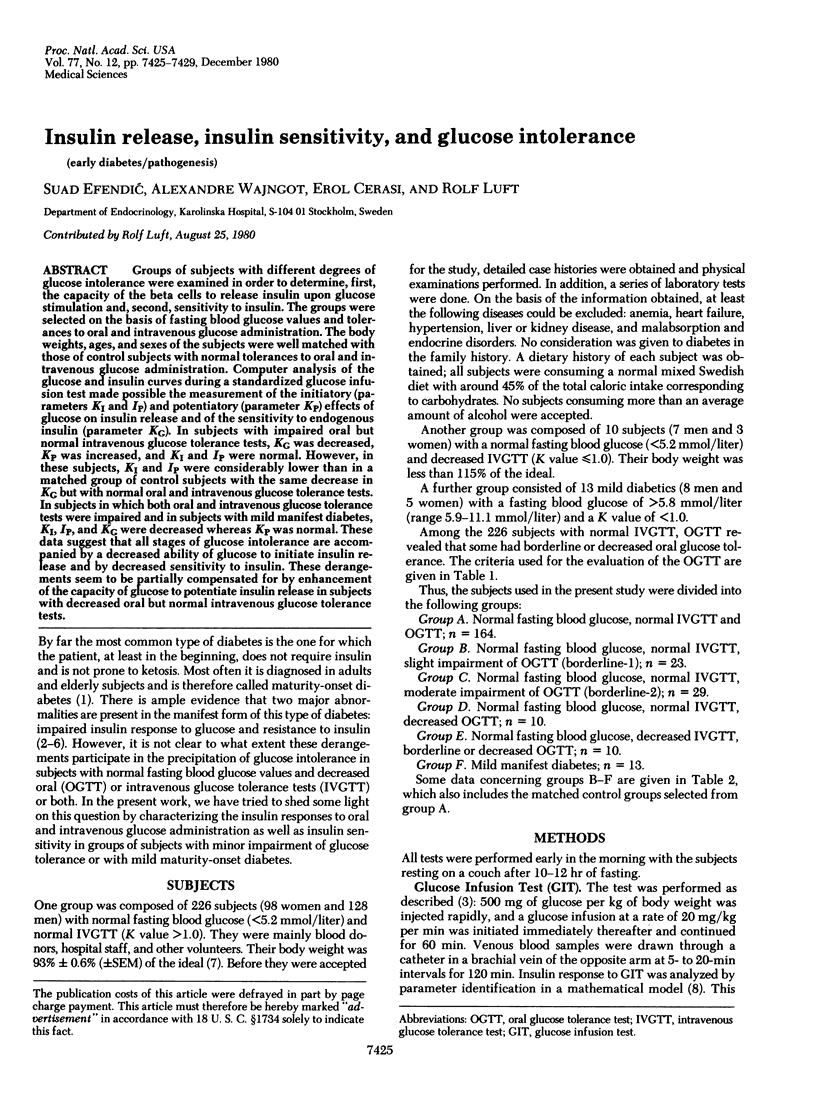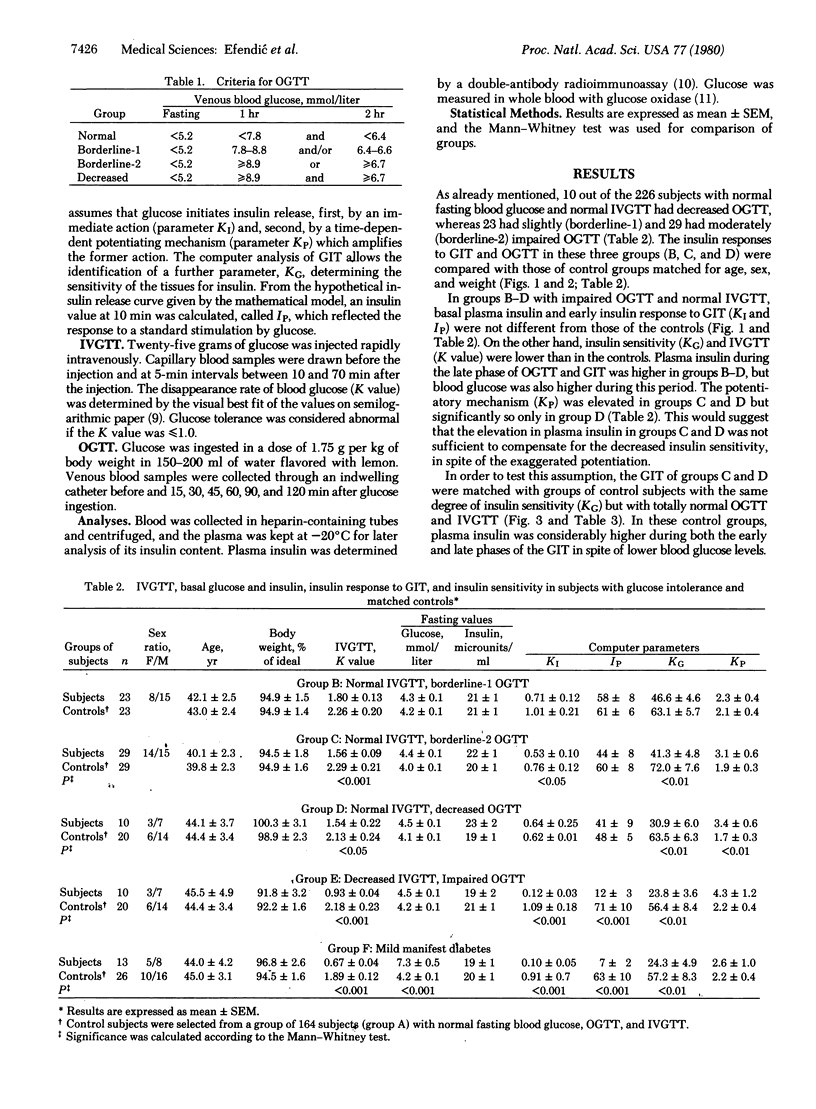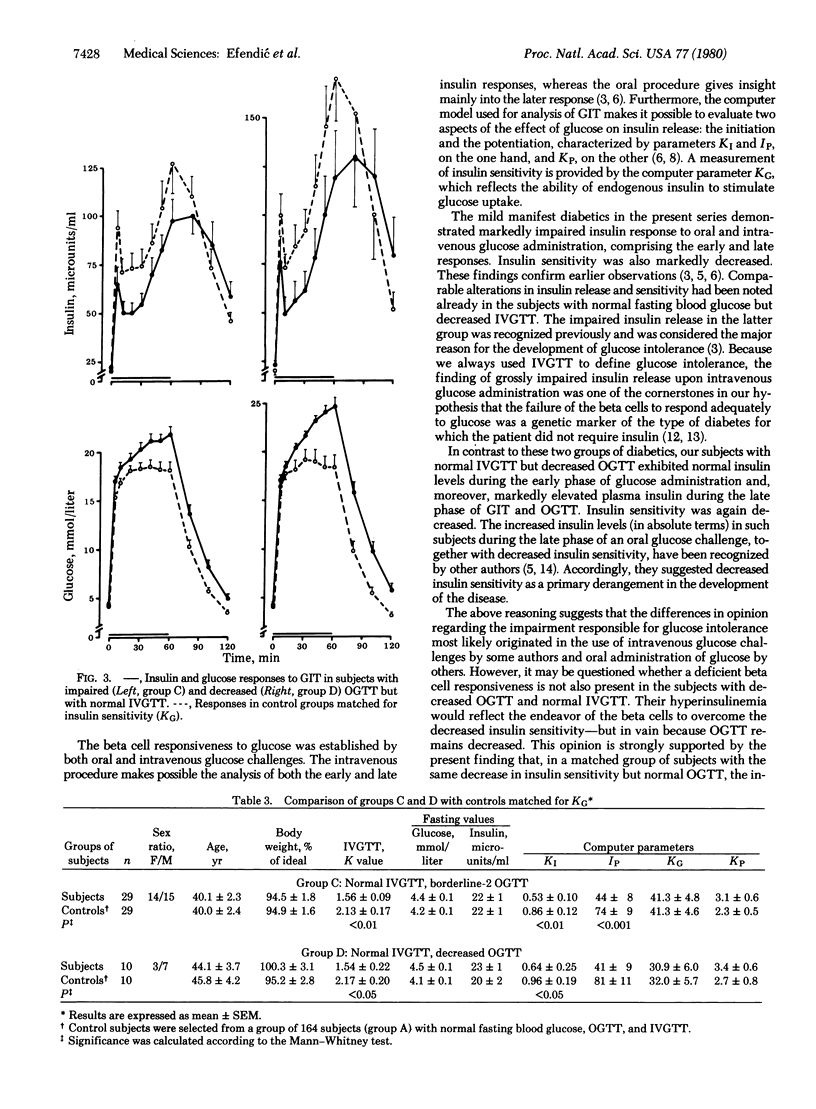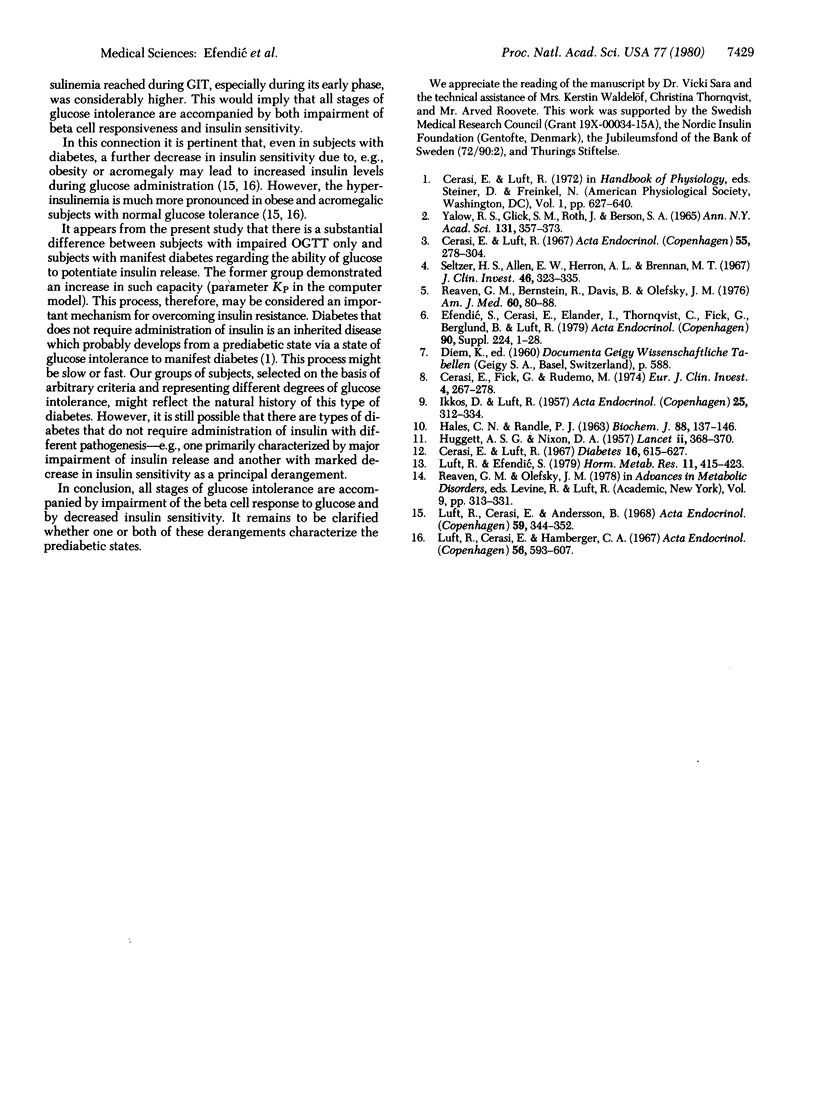Abstract
Groups of subjects with different degrees of glucose intolerance were examined in order to determine, first, the capacity of the beta cells to release insulin upon glucose stimulation and, second, sensitivity to insulin. The groups were selected on the basis of fasting blood glucose value and tolerances to oral and intravenous glucose administration. The body weights, ages, and sexes of the subjects were well matched with those of control subjects with normal tolerances to oral and intravenous glucose administration. Computer analysis of the glucose and insulin curves during a standardized glucose infusion test made possible the measurement of the initiatory (parameters KI and IP) and potentiatory (parameter KP) effects of glucose on insulin release and of the sensitivity to endogenous insulin (parameter KG). In subjects with impaired oral but normal intravenous glucose tolerance tests, KG was decreased, KP was increased, and KI and IP were normal. However, in these subjects, KI and IP were considerably lower than in a matched group of control subjects with the same decrease in KG but with normal oral and intravenous glucose tolerance tets. In subjects in which both oral and intravenous glucose tolerance tests were impaired and in subjects with mild manifest diabetes, KI, IP, and KG were decreased whereas KP was normal. These data suggest that all stages of glucose intolerance are accompanied by a decreased ability of glucose to initiate insulin release and by decreased sensitivity to insulin. These derangements seem to be partially compensated for by enhancement of the capacity of glucose to potentiate insulin release in subjects with decreased oral but normal intravenous glucose tolerance tests.
Full text
PDF




Selected References
These references are in PubMed. This may not be the complete list of references from this article.
- Cerasi E., Fick G., Rudemo M. A mathematical model for the glucose induced insulin release in man. Eur J Clin Invest. 1974 Aug;4(4):267–278. doi: 10.1111/j.1365-2362.1974.tb00403.x. [DOI] [PubMed] [Google Scholar]
- Cerasi E., Luft R. "What is inherited--what is added" hypothesis for the pathogenesis of diabetes mellitus. Diabetes. 1967 Sep;16(9):615–627. doi: 10.2337/diab.16.9.615. [DOI] [PubMed] [Google Scholar]
- Cerasi E., Luft R. The plasma insulin response to glucose infusion in healthy subjects and in diabetes mellitus. Acta Endocrinol (Copenh) 1967 Jun;55(2):278–304. doi: 10.1530/acta.0.0550278. [DOI] [PubMed] [Google Scholar]
- HALES C. N., RANDLE P. J. Immunoassay of insulin with insulin-antibody precipitate. Biochem J. 1963 Jul;88:137–146. doi: 10.1042/bj0880137. [DOI] [PMC free article] [PubMed] [Google Scholar]
- HUGGETT A. S., NIXON D. A. Use of glucose oxidase, peroxidase, and O-dianisidine in determination of blood and urinary glucose. Lancet. 1957 Aug 24;273(6991):368–370. doi: 10.1016/s0140-6736(57)92595-3. [DOI] [PubMed] [Google Scholar]
- IKKOS D., LUFT R. On the intravenous glucose tolerance test. Acta Endocrinol (Copenh) 1957 Jul;25(3):312–334. doi: 10.1530/acta.0.0250312. [DOI] [PubMed] [Google Scholar]
- Luft R., Cerasi E., Andersson B. Obesity as an additional factor in the pathogenesis of diabetes. Acta Endocrinol (Copenh) 1968 Oct;59(2):344–352. doi: 10.1530/acta.0.0590344. [DOI] [PubMed] [Google Scholar]
- Luft R., Cerasi E., Hamberger C. A. Studies on the pathogenesis of diabetes in acromegaly. Acta Endocrinol (Copenh) 1967 Dec;56(4):593–607. doi: 10.1530/acta.0.0560593. [DOI] [PubMed] [Google Scholar]
- Luft R., Efendić S. Low insulin response -- genetic aspects and implications. Horm Metab Res. 1979 Jul;11(7):415–423. doi: 10.1055/s-0028-1092751. [DOI] [PubMed] [Google Scholar]
- Reaven G. M., Bernstein R., Davis B., Olefsky J. M. Nonketotic diabetes mellitus: insulin deficiency or insulin resistance? Am J Med. 1976 Jan;60(1):80–88. doi: 10.1016/0002-9343(76)90536-2. [DOI] [PubMed] [Google Scholar]
- Seltzer H. S., Allen E. W., Herron A. L., Jr, Brennan M. T. Insulin secretion in response to glycemic stimulus: relation of delayed initial release to carbohydrate intolerance in mild diabetes mellitus. J Clin Invest. 1967 Mar;46(3):323–335. doi: 10.1172/JCI105534. [DOI] [PMC free article] [PubMed] [Google Scholar]
- Yalow R. S., Glick S. M., Roth J., Berson S. A. Plasma insulin and growth hormone levels in obesity and diabetes. Ann N Y Acad Sci. 1965 Oct 8;131(1):357–373. doi: 10.1111/j.1749-6632.1965.tb34803.x. [DOI] [PubMed] [Google Scholar]


